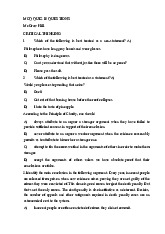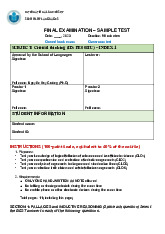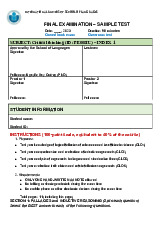


























Preview text:
CRITICAL THINKING
Course code: PE008IU (3 credits) Instructor: TRAN THANH TU Email: tttu@hcmiu.edu.vn 1 What is a Fallacy?
l A (logical) fallacy is an argument that contains
a mistake in reasoning.
l Fallacies can be divided into two general types:
l Fallacies of Relevance
Arguments in which the premises are logically irrelevant to the conclusion.
l Fallacies of Insufficient Evidence
Arguments in which the premises, though
logically relevant to the conclusion, fail to
provide sufficient evidence for the conclusion. 2
Review: Fallacies of Relevance
l A fallacy of relevance occurs when an arguer offers
reasons that are logically irrelevant to his or her conclusion.
l Eleven Fallacies of Relevance:
1. Personal Attack 7. Bandwagon
2. Attacking the Motive Argument
3. Look Who’s Talking 8. Straw Man
4. Two Wrongs Make a Right 9. Red Herring 5. Scare Tactics 10. Equivocation
6. Appeal to Pity 11. Begging the Question 3 Fallacies of Insufficient Evidence
Arguments in which the premises,
though logically relevant to the conclusion, fail to provide
sufficient evidence to support the conclusion. 5 Fallacies of Insufficient Evidence 1. Inappropriate Appeal 6. Hasty Generalizations to Authority 2. Appeal to Ignorance 7. Slippery Slope 3. False Alternatives 8. Weak Analogy 4. Loaded Question 9. Inconsistency 5. Questionable Cause 10. Composition and Division 6
1. Inappropriate Appeal to Authority
Inappropriate Appeal to Authority Citing a
a witness or authority that is untrustworthy. y Ti T ps Au A t u h t or o itiy y As A s s e s s e sm s e m n e t n 1. Is the source an au a t u h t o h r o i r ty t y on o n th t e h e su s b u j b ec e t c at issue? 2. Is the source bi b a i s a e s d e ? 3. Is the ac a c c u c r u a r c a y c
of the source observations questionable?
4. Is the source known to be generally un u r n e r l e i l a i b a l b e l ? 5. Has the source been ci c t i ed e d co c r o r r ec e t c l t y l ? 6. Does the source’s cl c a l i a m m co c n o f n l f i l ct c with expert opinion?
7. Can the source’s claim be settled by an ap a p p e p a e l a lto t o ex e p x e p r e t r opinion? 8. Is the claim highly improbable on its face? 7 1. Inappropriate Appeal to Authority - Example Example:
My barber told me that Einstein’s general theory
of relativity is a lot of hogwash. I guess Einstein
wasn’t as smart as everybody thinks he was.
Tuan and Hoa are having a conversation:
l Hoa: "I played the lottery today and I know I am going to win something.“
l Tuan: "What did you do, rig the outcome?"
l Hoa: "No, silly. I called my fortune-teller. After
consulting his magic Tarot deck, he told me my lucky numbers." 8 2. Appeal to Ignorance Ap A p p ea e l a to t o Ig I no n r o an a c n e c
Claiming that something is true because no one has proven it false or vice versa. l Example:
l There must be intelligent life on other planets. No one has proved that there isn’t.
l No one has proven that humans are not responsible for
global warning. Therefore, we must conclude that humans
are responsible for global warning.
“Not proven, therefore false”
If such reasoning were allowed, we could prove almost Remember any conclusion. 9 3. False Alternatives Fa F l a s l e s Al A tle t rn r a n t a iv i es e Posing a a false ei e ther/or choice. Examples:
• You can either vote Republican or Democrat,
but you don’t want a Democrat, so you must vote Republican.
• If we don’t elect a Democrat the economy will
go down the tubes and we don’t want that! So we should elect a Democrat. Fallacy of false alternatives can involve more than two (2) )alternatives
. It can also be expressed as a Remember
conditional (i f-then ) statement. 10 4. Loaded Question Loaded Question Posing a
a question that contains an unfair or unwarranted presupposition. To
T respond to a loaded question effectively , one must Ti T p
distinguish the different questions being asked and respond to each individually. 11 4. Loaded Question Example:
Joe: Have you stopped cheating on exams? Pete: No!
Joe: Oh, so you admit that you still cheat on exams? Pete: No, I meant to say yes!
Joe: Oh, so you admit that you used to cheat on exams? Pete: No!
Lee: Are you still friends with that loser Richard? Ali: Yes.
Lee: Well, at least you admit he is a total loser. 12 5. Questionable Cause Qu Q e u st s itona n b a le l Cau a se s Claiming, without suff
f icient evidence, that one thing
is the cause of something else. Example:
How do I know that ginseng tea is a cure for the common
cold? Last week I had a bad case of the sniffles. I drank a cup
of ginseng tea, and the next morning my sniffles were gone.
Many homosexuals have AIDS. Therefore, homosexuality causes AIDS.
1. A and B are associated on a regular basis. Pattern
2. Therefore A is the cause of B. 13 6. Hasty Generalization Ha H s a t s y y G e G n e e n r e a r lilzat a iton Dr D a r wi w ng n a gen e e n ra r l lc o c n o c n l c us u ion o fro r m m a sam a p m le e th t a h t t is biased or too small.
1. A biased sample is one that is not representative of the target population. 2. The target population
is the group of people or things
that the generalization is about. Pattern
3. Hasty generalizations can often lead to false stereotypes . 14 6. Hasty Generalization Example:
Do most Americans still believe in God? To find out,
we asked more than ten thousand scientists at
colleges and universities throughout America.
Less than 40 percent said that they believed in God.
The conclusion is obvious: Most Americans no longer believed in God.
Four out of five dentists recommend Happy Glossy
Smile toothpaste brand. Therefore, it must be great. 15 6. Hasty Generalization Example:
Do most Americans still believe in God? To find out,
we asked more than ten thousand scientists at
colleges and universities throughout America.
Less than 40 percent said that they believed in God.
The conclusion is obvious: Most Americans no longer believed in God.
Four out of five dentists recommend Happy Glossy
Smile toothpaste brand. Therefore, it must be great. 16 7. Slippery Slope Slippery y Slope p Claiming, without suff f icient evidence, that a a seemingly harmless action, if f taken, will lead to a a di d sastrous outcome.
Dr. Perry has proposed that we legalize physician – assisted
suicide. No sensible person should listen to such a proposal. If
we allow physician – assisted suicide, eventually there will be no respect for human life. 1.
The arguer claims that if a certain seemingly harmless action, A,
is permitted, A will lead to B, B will lead to C, and so on to D.
2. The arguer holds that D is a terrible thing and therefore should not be permitted. Patter
3. In fact, there is no good reason to believe that A will actually 17 n lead to D.
7. Slippery Slope - Example
l We cannot unlock our child from the closet
because if we do, she will want to roam the house. (95%)
l If we let her roam the house, she will want to roam the neighborhood. (10%)
l If she roams the neighborhood, she will get
picked up by a stranger (0.05%) in a van
(35%), who will sell her in a sex slavery ring
(0.07%) in some other country (40%).
Therefore, we should keep her locked up in the closet. 18
7. Slippery Slope - Example
l We cannot unlock our child from the closet
because if we do, she will want to roam the house. (95%)
l If we let her roam the house, she will want to roam the neighborhood. (10%)
l If she roams the neighborhood, she will get
picked up by a stranger (0.05%) in a van
(35%), who will sell her in a sex slavery ring
(0.07%) in some other country (40%).
Therefore, we should keep her locked up in the closet. 19 8. Weak Analogy We W a e k An A alo l gy Comparing things that aren’t ’ really comparable.
(X has characteristics a, b, c, and d
Y has characteristics a, b, and c
So, Y probable has characteristic d, too)
1. List all important similarities between the two cases.
2. List all important dissimilarities between the two cases.
3. Decide whether the similarities or dissimilarities are Ti T p more important. 20 8. Weak Analogy Example:
Lettuce is leafy and green and tastes great with a
veggie burger. Poison ivy is also leafy and green.
Therefore, poison ivy probably tastes great with a veggie burger, too.
Hockey sticks are long and hard, and can be used
as a weapon. A French bread, “Baguette” is long
and hard too. Most probably, it can be used as a weapon. 21 8. Weak Analogy Example:
Lettuce is leafy and green and tastes great with a
veggie burger. Poison ivy is also leafy and green.
Therefore, poison ivy probably tastes great with a veggie burger, too.
Hockey sticks are long and hard, and can be used
as a weapon. A French bread, “Baguette” is long
and hard too. Most probably, it can be used as a weapon. 22 9. Inconsistency Inconsistency y As A s s e s r e titng n g i n i c n o c ns n i s st s e t n e t tor r c o c n o t n r t a r di d ct c o t ry r y c l c a l i a ms m . s Example:
l MM: Key, Yogi, what do you say we eat at Toots’ tonight?
l Yogi: That place is old news. Nobody goes there anymore. It’s too crowded.
It is also a mistake to cling cling stubbornly to an old idea when new
information suggests that the idea is false. Remember
Open-minded to new ideas = Learning 23
10. Composition and Division Composition As A s s u s m u i m ng n , wi w th t ou o t tgoo o d d re r as a o s n o , ,t h t a h t a twh w a h t a is s t r t u r e u e o f o f th t e e pa p rt r s t is also true of the whole. Di D vi v si s on n As A s s u s m u i m ng n , wi w th t ou o t tgoo o d d re r as a o s n o , ,t h t a h t a twh w a h t a is s t r t u r e u e o f o f a a w h w o h l o e l is also true of its parts. Example: •
Each of my monthly car payments is low. So, the total
price of the car will be low. à Composition fallacy •
This box is heavy, so everything in this box must be heavy. à Division fallacy •
Finns are highly literate. Therefore, Lasse, a 2-year-
old Finnish child, must be literate. à Division fallacy 24 TYPES OF ARGUMENTS Deductive arguments Inductive arguments 3.1.1 Hypothetical syllogism 3.2.1 Inductive generalization 3.1.2 Categorical syllogism 3.2.2 Predictive argument 3.1.3 Argument by 3.2.3 Argument from elimination authority 3.1.4 Argument based on 3.2.4 Causal argument mathematics 3.2.5 Statically argument 3.1.5 Argument from 3.2.6 Argument from analogy definition 25
Fallacy: An argument that contains a mistake in reasoning. Fallacies of Relevance (11)
Fallacies of Insufficient Evidence (9)
Arguments in which the premises
Arguments in which the premises,
are logically irrelevant to the
though logically relevant to the conclusion.
conclusion, fail to provide sufficient evidence for the conclusion. q Personal Attack (Ad hominem) q
Inappropriate Appeal to Authority q Attacking the Motive q Appeal to Ignorance q
Look Who’s Talking (Tu quoque) q False Alternatives q Two Wrongs Make a Right q Scare Tactics q Loaded Question q Appeal to Pity q Questionable Cause q Bandwagon Argument q Hasty Generalization q Straw Man q Slippery Slope q Red Herring q Weak Analogy q Equivocation q Begging the Question q Inconsistency q Composition and Division 26 Fallacies of relevance
l Do Homework 6.1 I and II in page 155-161. l Exclude examples. l No need to submit. Date: Group: … Homework: 6.1 I and II Answer: 2. … 3… 5… … 27




